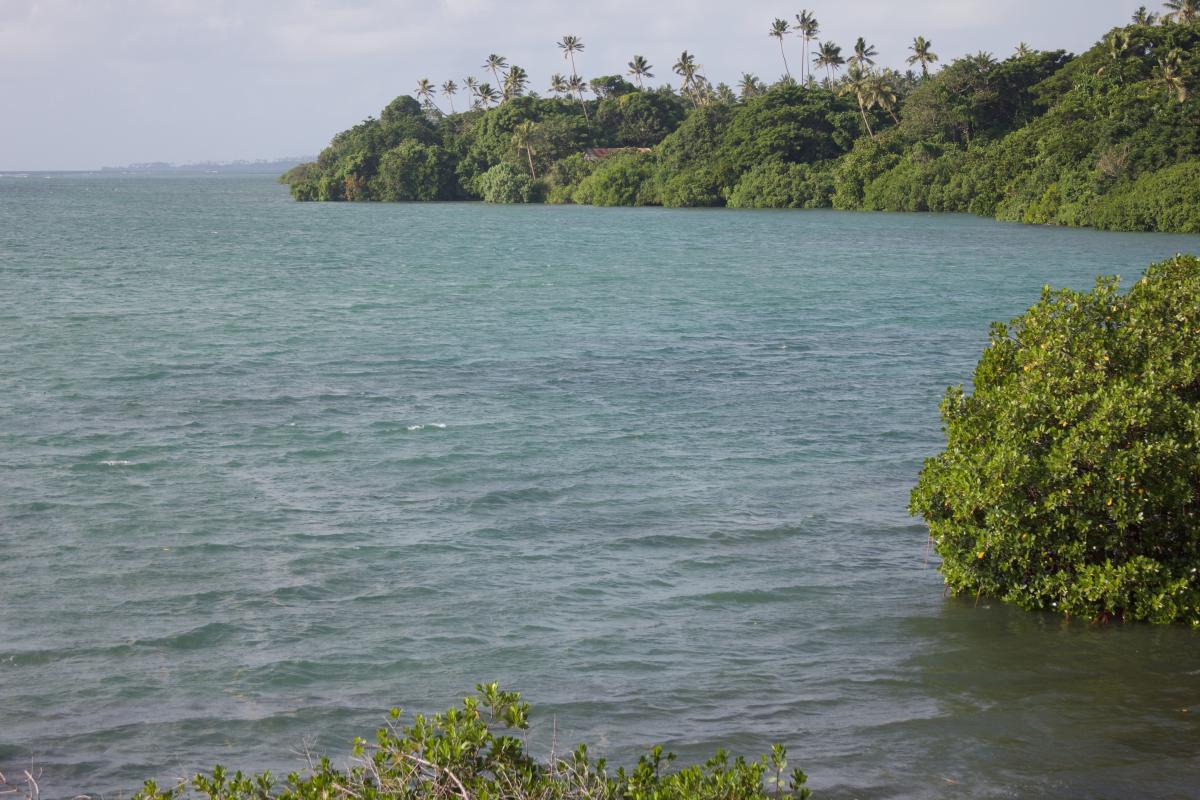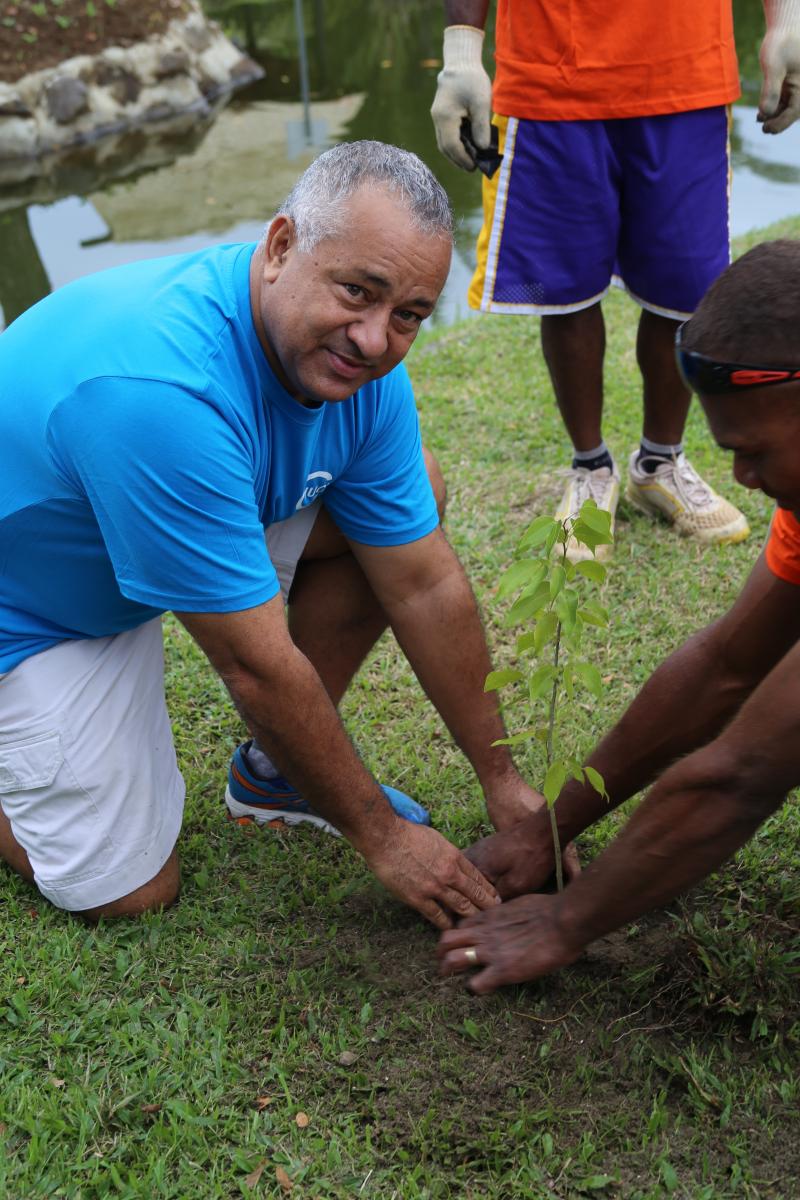Gift of mangroves: Nature's nursery
I grew up in a remote rural area of Northern Vanua Levu, Fiji’s second largest island. Due west from the International Date Line, across the Somosomo Strait, set between Taveuni Island and Vanua Levu, in an area commonly known as Ucunivatu lies tranquil Naiqaiqai Bay, fringed by mangroves, a place of refuge for ships during a natural disaster.
Growing up, my playground was the Bay, where the mangrove forest meets the sea. It is where traditional knowledge taught us the many uses of this versatile tree and sustainable harvesting infused our rural upbringing.
Naiqaiqai Bay with its mangrove forest is a sight to see; nature’s own nursery that many species of marine life call home among the long dangling roots of the Red Mangroves (Tiri), rotting leaves and soft black mud – an ecosystem on its own. Black Mangroves (Dogo) dot the coastline, wind-beaten and leaning ever so gently. Further in, there is another type of mangrove, straight with slender trunks, these made for good posts and beams for traditional Fijian bures.
I recall going out to catch mud crabs at night with a homemade spear and a benzene lamp, bare feet and hands, resulting in getting bitten a few times but learning my lesson rather quickly! Back than crabs were plentiful, large and for the most part only male crabs made it to the dinner table because we were always encouraged to put the female crabs back. Times have changed and now my sons go kayak crabbing, finding their favourite spot as they cast their crab baskets into the bay hoping for a few big ones. When they do catch a few, you can hear their screams of joy all the way down the bay!
Inland where the water is brackish, you could find prawns, a delicacy in the village. Amongst the roots and branches of the tiri, we would often see mangrove periwinkle and at spring tide kuka (crab) would fill our coconut leaf baskets. At the base of the dogo, we built chimney-shaped mud mounds, and would stamp our feet to entice the mana (scorpion-like crabs) to scramble up from the safety of their burrows into our waiting hands – once cleaned and boiled, the meat of the mana infused with coconut milk (lolo) is to die for! In-between the tiri and dogo, seashells (kaikoso and qeqe) abound. This made for quick and easy meals. When the tide was right, we went snorkelling and spearfishing for nuqa and damu plus the many other fish species that made mangroves their home. Our first stop after spearfishing would be the dogo-fired copra dryer to cook our fish over the hot ambers of the dryer.
In addition to being a food source, mangroves was widely used as bush medicine. Growing up, we would often get treated with traditional herbal medicine, a concoction involving some parts of the mangrove and barks of other trees, leaves and vines. To this day, I can still taste the medicine in my palate!
Fast forward a few decades, I am saddened to see the destruction of these mangroves forests, cut down in the name of development. In the past century alone, 67% of global mangroves have been lost and the global rates of mangrove loss are 3 – 4 times greater than for overall forest loss. If this rate of loss continues all unprotected mangroves will be lost in the next 100 years. This mangrove loss has also been observed in the region and is attributed to both natural and human interventions.
Despite the loss of mangroves, efforts are underway globally to protect, conserve, restore and sustainably manage these ecosystems which are so vital to sustaining both coastal communities and biodiversity. In June 2017, at the high-level United Nations Ocean Conference held at UN Headquarters in New York, over 1,400 voluntary commitments for concrete action to advance the implementation of SDG 14 on Oceans were made by governments, the United Nations system, civil society organizations, academia, the scientific community, and the private sector.
The importance of mangroves to ocean health is reflected in the nearly 90 voluntary commitments (to date) that relate to the restoration, rehabilitation, protection and management of mangroves and associated ecosystems. These voluntary commitments reflect the vital role that mangroves play in supporting livelihoods of coastal communities, sustainable fisheries, resilience to the impacts of climate change and sequestering atmospheric CO2. Specific commitments relate to topics such as development of protected areas, reforestation, mapping, economic valuation, tourism, financing, mangrove livelihoods, climate adaptation and blue carbon.
Globally, the designated Focal Points for the Community of Ocean Action on Mangroves are IUCN’s Director General Ms. Inger Andersen and Ramsar’s Secretary General Ms. Martha Rojas Urrego. The main aim of the Community of Ocean Action on Mangroves is to raise awareness of the issues confronting mangrove ecosystems and the solutions to address them, to highlight best practices in mangrove conservation, as well as successful initiatives and projects that can be scaled up and replicated. You can visit the Community’s website https://oceanconference.un.org/coa/Mangroves for more information. Here in the Oceania region this important work is coordinated out of the IUCN Oceania Regional Office in Suva. Should you or your community wish to receive assistance in implementing any existing commitments, or if you wish to become a member of the Community of Ocean Action on Mangroves, or if you wish to register new voluntary commitments on mangroves, you can visit the website above, or you can reach us at https://www.iucn.org/regions/oceania, or drop by at the office at 5 Ma’afu Street Suva. Together we can protect, conserve, restore and sustainably manage our mangroves.
The Global Mangroves Alliance is a global partnership between IUCN, CI, TNC, WWF, and Wetlands International that have come together to coordinate their efforts to protect, conserve, restore and sustainably manage our mangroves. It is indeed encouraging to note the efforts of a number of Pacific Island countries in implementing their voluntary mangroves commitments. The Samoan Ministry of Natural Resources & Environment has committed to ensuring mangroves are preserved for their social, economic, and cultural benefits to Pacific Island communities through research, capacity building, and the establishment of mangrove protected areas for mangrove rehabilitation and protection. #OceanAction16546 https://oceanconference.un.org/commitments/?id=16546
Through a community-based approach, Kiribati is committed to the development of mangrove-integrated ecological aquaculture and other alternative livelihood activities, and to developing sustainable management practices to control land-based pollution to coastal systems in Tarawa to fight against the deterioration of mangroves, seagrass beds, and lagoons fisheries due to upstream pollution. #OceanAction20179 https://oceanconference.un.org/commitments/?id=20179
Fiji is committed to empowering communities to scale up efforts to create an effectively managed and governed network of locally managed marine areas in all Fijian communities covering 100% of Fijis customary marine areas by 2025. #OceanAction21668 https://oceanconference.un.org/commitments/?id=21668.
The Department of Environment in Fiji has committed to protecting the well-being and food security of Fijians through an Integrated Coastal Management Plan with a ridge-to-reef planning and management approach through alternative waste and wastewater management options, expansion of both community based and large scale marine protected areas, and restoration of rivers, riparian buffers, and mangrove forests. #OceanAction19984 https://oceanconference.un.org/commitments/?id=19984
#OceanAction19904 https://oceanconference.un.org/commitments/?id=19904
Here in the region, the Pacific Mangroves Initiative (PMI), established by IUCN in 2009, is a partnership-based initiative promoting investment and action for sustainable mangrove futures in the Pacific Islands and to implement sound practices and capacity building in mangrove management. The initiative also aims to raise awareness on the value of coastal ecosystem goods and services and build capacity at all levels to help local governments make informed decisions. The initiative looks upon mangroves as the flagship ecosystem in an integrated approach to coastal ecosystem management. Current partners are the Secretariat of the Pacific Regional Environment Programme, the United Nations Development Programme and the following countries: Fiji, Vanuatu, Papua New Guinea, Samoa, Solomon Islands and Tonga.
Mangrove areas in some Pacific Island countries are high relative to their land area, such as 12% of the Federated States of Micronesia, and 10% of PNG and Palau. Pacific Islanders were and still are traditionally coastal resource based, with many early settlements close to mangrove areas. They continue to provide significant social, economic and cultural benefits for the over ten million people of the Pacific Islands, . The key areas of focus of PMI are to improve communication and awareness, assist with policy and legislation review, provide technical assistance for information and research, and assist with site action for the conservation and sustainable management of mangroves, and the coordination of on-site implementation. To date, the Pacific Mangroves Initiative has delivered two regional mangrove projects:
- the Mangrove Ecosystem for Sustainable Climate Change Adaptation and Livelihoods (MESCAL) project - implemented in Fiji, Samoa, Solomon Islands, Tonga and Vanuatu and
- the Mangrove Rehabilitation for Sustainably-Managed Forest (MARSH) project - implemented in PNG, Solomon Islands and Vanuatu.
This year, World Mangroves Day will again be celebrated on Thursday 26 July 2018 in conjunction with the first year anniversary of the launch of the Global Mangrove Alliance (GMA) in Fiji. As part of this celebration, the Fiji GMA Partners (CI, WWF and IUCN) along with Fiji’s Department of Environment, Lands and Forestry and its conservation partners, including World Conservation Society, Birdlife, RAMSAR, Nature Fiji amongst others, co-hosted the mangroves celebration event at the My Suva Park foreshore.
The next time you visit the beach, take your time to observe our mangrove forest and you will be surprised at the many services it provides; from preventing coastal erosion, providing food, fibre and medicine.
Let’s give back to nature. Take a stand, together we can protect, conserve, restore and sustainably manage our mangroves.


